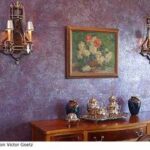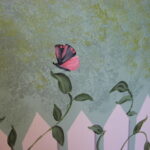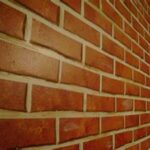Color washing is a fairly simple faux finish paint technique that yields beautiful results. It has a soft, feathery look that is accented by a slight textured finish. This paint technique will add depth and dimension to the walls, and has an overall cozy feel to it that looks great with virtually any home decor or design. If you are working with slightly damaged or imperfect walls, color washing will be a simple way to disguise them.
Like most other paint techniques, color washing is a two step process. You’ll begin by applying a base coat of paint, followed by a mixture of transparent or tinted glaze and top coat paint. By mixing the glaze, you can customize your color wash to the exact thickness and transparency you desire. The more glaze you use, the more transparent the result, meaning that the base coat will be more apparent.
Supplies needed for color washing:
– Off-white base coat
– Top coat (In color of your choice)
– Glaze
– Paint roller and roller head
– Paint tray
– Bucket
– Sea sponge or rag
– Drop cloth
Color washing faux paint technique:
STEP 1 – Lay down a drop cloth to protect the flooring and any surface areas.
STEP 2 – Apply base coat to the walls and allow to dry overnight.
STEP 3 – In a bucket, combine two parts glaze to one part top coat paint. Remember, the glaze can be reduced or increased, depending on how you want the finished result to look. Use a paint stirrers to thoroughly mix the two.
Sea sponge or rag? To apply the color wash, you have two options. You can either use a sea sponge, which will give a more textured appearance on the walls, or a rag, which will provide a more subtle, feathery look. Both are equally easy to use.
STEP 4 – Once you’ve decided on your application tool, dip it in the glaze and apply to the wall. You’ll want to work in small, 4′ sections at a time. This will ensure an even coat of color wash to the entire room.
STEP 5 – This paint technique is called color washing because when it’s applied, it’s ‘washed’ on the walls. You will literally repeat the same movement you would if you were washing down the walls with soap and water. But remember – Don’t cover the entire wall space at one. Work in small sections, making sure that each section comes in contact with the other. Leave no area of the wall untouched!
Repeat the ‘washing’ process until the entire area is covered. As it dries, the color washing will become more obvious and you’ll see the beauty of this faux finish paint technique take place.
More from Jennifer Wagner:
DIY Faux Painting: Marbling
Shabby Chic Paint Technique
DIY Faux Painting: Wood Graining
SOURCE:
Personal knowledge and experience
Jennifer Wagner – Yahoo! Contributor Network






